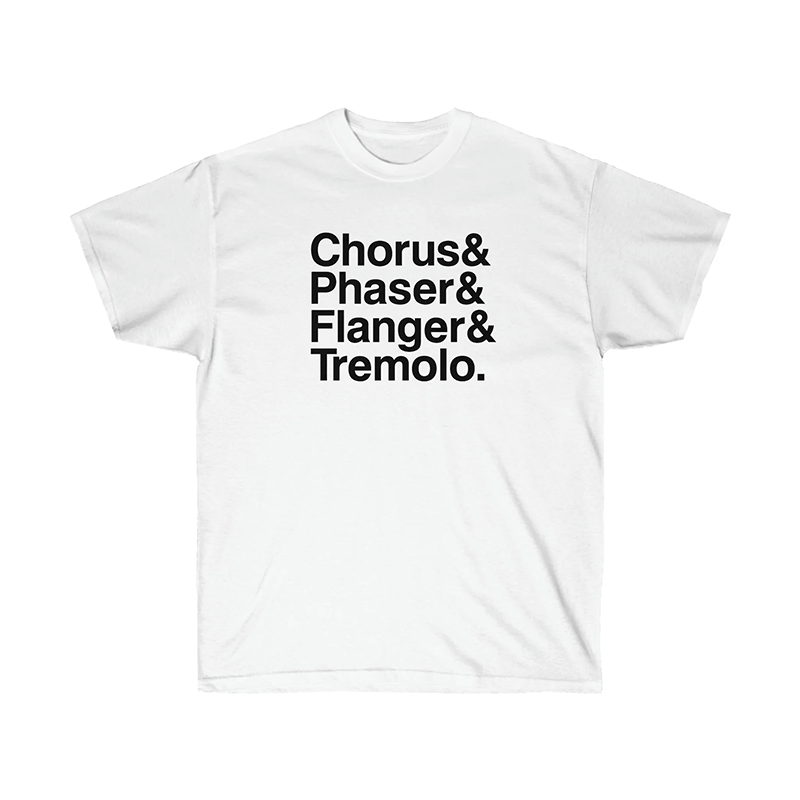What happens when a company runs out of an important piece of the sonic puzzle that has been used in manufacturing one of their most popular pedals? The price of the ones already in existence goes through the roof, which happens to be the case with today’s pedal, the absolutely fantastic Moogerfooger MF-104M Delay, the final pedal of our “Moog Week” run here at Pedal of the Day. This all-analog delay is no longer in production, making it that much rarer, but the fact that it is also considered one of the finest delays ever made doesn’t hurt its reputation, either.
Time (delay) and Feedback (repeats) are the main controls on the Delay side of the MF-104M, both containing wide ranges to play around with. Plus, there’s a Short (40ms-400ms)/Long(80ms-800ms) switch for the delay time, meaning you can adjust your delay accordingly to fit right in with whatever song you’re playing, or switch back and forth for a barrage of feedback-induced delay craziness. There’s a Tap Tempo feature that works here as well, more on that in a minute.
The LFO (Low Frequency Oscillation) side of the pedal has a couple of controls for dialing in some wicked modulation-type effects. Six different LFO waveform shapes (sine, triangle, square, saw, reverse saw, and sample and hold) allow you to experiment til the cows come home, while Rate adjusts the LFO rate from 0.05Hz to 50Hz, and Amount adds or subtracts the level of modulation that is present overall in the delayed effect.
There’s a complete middle section as well, featuring Drive (add in some gain), Output Level (overall output volume control) and Mix, which blends your instrument’s dry signal with the wet signal from the MF-104M. A row of three LEDs near the bottom let you know your delay time, input level and whether the pedal is in Bypass mode or it is engaged. You can also press and hold the Bypass switch to engage or disengage the Spillover mode, which will trails off your delay effect even after you turn off the pedal.
The MF-104M Analog Delay features up to 800 milliseconds of delay…or does it? Using the Tap Tempo function on the Short setting, tap in the longest delay time you can, then switch over to the Long setting and marvel in the new length of your delay (cool trick, eh?). You can also assign the tap function to control either the delay time OR the LFO section, making for all kinds of sonic exploration. Plus, there’s a bunch of expression pedal jacks on the back panel, as usual, for controlling practically every aspect of this pedal, if you’ve got room for all those expressions! This delay really has so many options, plus you can connect it using MIDI and even add another effect into the delay, making it truly a one-of-a-kind, standalone piece of musical equipment, almost like another instrument in your sonic arsenal.
Unfortunately, pedals like this that are built using rare chips all pretty much have the same thing happen: the chips eventually run out, and therefore, so does the manufacturing of the pedals. Earlier this year, Moog announced they had depleted their supply of the “Bucket Brigade” chips used in their delay models, and were therefore not going to be making any more. This shot the MF-104M’s price tag up into the stratosphere, where it still remains, with no signs of slowing down. If you want to get your hands on one, you’re going to first have to track it down, then sell your car or your first born to be able to buy it. Not exactly, buy they’re not cheap – however, if you’re able to pick one up, you’re going to be in delay heaven, and you’ll own a piece or never-seen-again effects history. Thanks for hanging with us during “Moog Week” here at Pedal of the Day, we hope you enjoyed the reading reviews as much as we did writing them! Make sure you go check out the Moog website as well, and prepare to be thoroughly amazed and inspired.
Specs:
Front Panel Features:
DRIVE: From -7dB to +28dB of input signal gain or attenuation
OUTPUT LEVEL: Use to optimize overall Output volume
MIX: Cross fader control to set the ratio of wet to dry signal
TIME: Control range of 40ms – 800ms of analog delay time
SHORT/LONG RANGE: Select between a short, bright delay 40ms to 400ms and a long, dark delay 80ms to 800ms
FEEDBACK: Continuous control of Delay line output fed back to Delay input from no Feedback to infinite.
WAVESHAPE: Selectable 6 Waveshape LFO for modulating the Delay Time
RATE: Controls the LFO Rate from 0.05 Hz to 50 Hz (Wider range available via CV and MIDI)
AMOUNT: Controls the overall Amount of LFO modulation of the Delay Time.
LEDs and Switches
TIME LED: The LED is Red when controlled by the Time knob, and Green when controlled by Tap Tempo.
LEVEL LED: Bi-Color LED displays input signal for optimum processing level.
BYPASS LED: When the effect is on the Bypass LED is green. When in Spillover mode the Bypass LED is orange. When the effect is off the Bypass LED is red
RATE LED: Indicates both the Rate and Waveform LFO settings. The LED is Red when the Rate is set from the front panel, Green when set by Tap Tempo, and Orange when the LFO is synced to MIDI clock. Note: When synced to MIDI clock, the Rate control is quantized to select only rhythmic subdivisions of the MIDI clock tempo.
TAP TEMPO: Tap Tempo control assignable to Delay Time or LFO Rate by holding down the switch. Time LED or Rate LED will flash Green to indicate Tap Tempo assignment.
SPILLOVER MODE: Press and hold Bypass to engage/disengage Spillover Mode.
REAR PANEL Features:
AUDIO IN: 1/4” TS jack that accepts any instrument level to line level audio signal.
MIX OUT: 1/4” TS jack with adjustable output level for instrument or line level output.
DELAY OUT: 1/4” TS jack that supplies wet-only output.
FEEDBACK, TIME, LFO RATE, MIX, LFO AMOUNT: All are 1/4” TRS jacks that accept Moog EP-2 (or equivalent) expression pedals, or 0-5VDC control voltages from either two-circuit (TS) or three-circuit (TRS) 1/4” jacks.
FEEDBACK INSERT: 1/4” TRS jack for inserting effects on the feedback loop of the Delay Line. Supplies line-level output.
MIDI IN: 5 Pin DIN input for controlling the MF-104M via MIDI.
+9VDC POWER JACK: Accepts standard 9 volt center positive barrel power adaptor (power adaptor included). 400mA minimum required.
Submitted by Mike B, Website
Demo Rock pedalboard by West Coast Pedalboard







